Burden of Proof in English Criminal Law
VerifiedAdded on 2020/05/16
|6
|1798
|84
AI Summary
This essay examines the principles of English criminal law, focusing specifically on the concept of 'burden of proof'. It analyzes landmark cases like *DPP v Woolmington* and *R v Edwards* to illustrate how this principle operates. The essay also discusses exceptions to the general rule, such as provocation and self-defense, highlighting relevant case law like *Mancini v DPP*. Finally, it concludes by summarizing the key takeaways regarding the burden of proof in English criminal law.
Contribute Materials
Your contribution can guide someone’s learning journey. Share your
documents today.
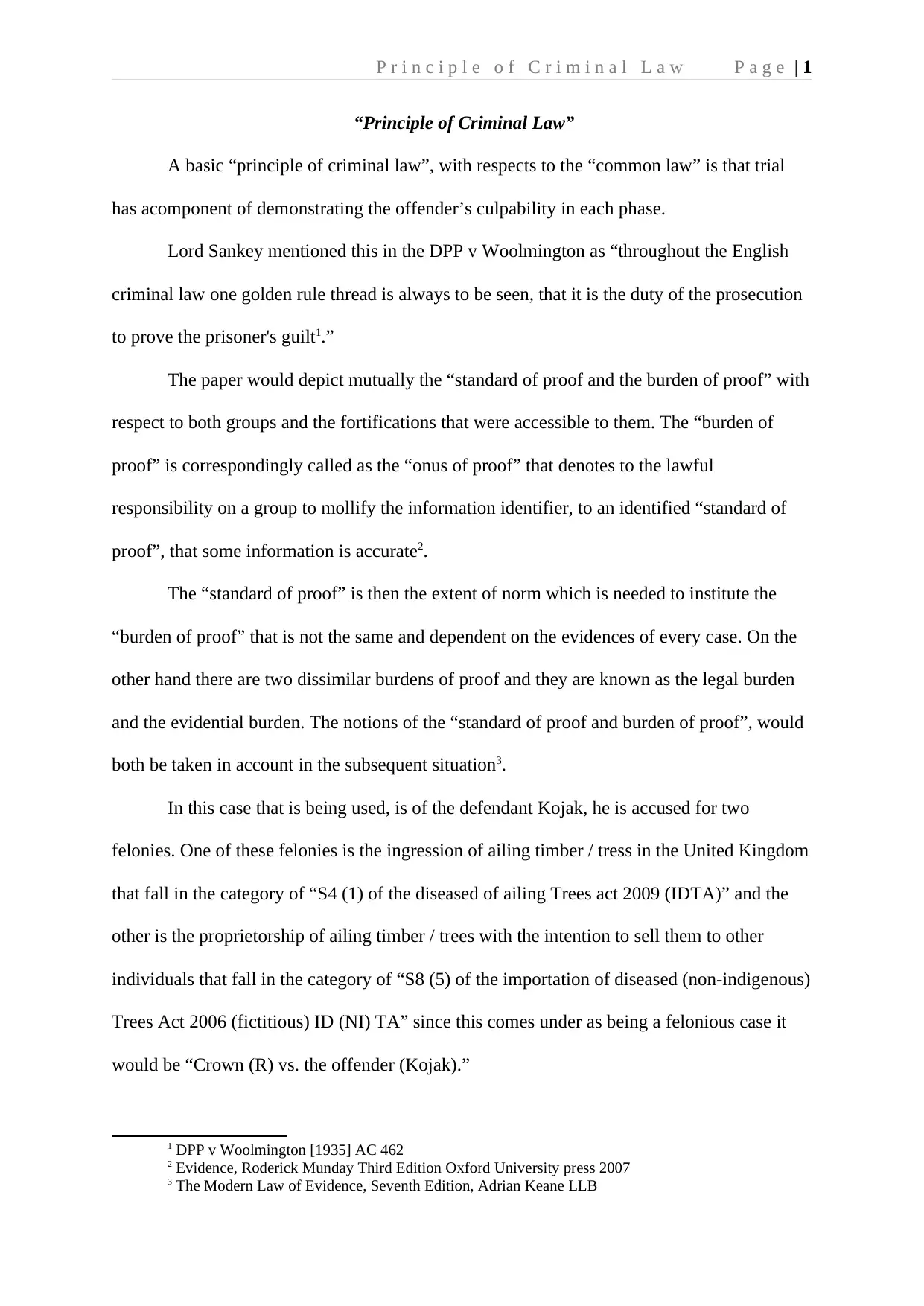
P r i n c i p l e o f C r i m i n a l L a w P a g e | 1
“Principle of Criminal Law”
A basic “principle of criminal law”, with respects to the “common law” is that trial
has acomponent of demonstrating the offender’s culpability in each phase.
Lord Sankey mentioned this in the DPP v Woolmington as “throughout the English
criminal law one golden rule thread is always to be seen, that it is the duty of the prosecution
to prove the prisoner's guilt1.”
The paper would depict mutually the “standard of proof and the burden of proof” with
respect to both groups and the fortifications that were accessible to them. The “burden of
proof” is correspondingly called as the “onus of proof” that denotes to the lawful
responsibility on a group to mollify the information identifier, to an identified “standard of
proof”, that some information is accurate2.
The “standard of proof” is then the extent of norm which is needed to institute the
“burden of proof” that is not the same and dependent on the evidences of every case. On the
other hand there are two dissimilar burdens of proof and they are known as the legal burden
and the evidential burden. The notions of the “standard of proof and burden of proof”, would
both be taken in account in the subsequent situation3.
In this case that is being used, is of the defendant Kojak, he is accused for two
felonies. One of these felonies is the ingression of ailing timber / tress in the United Kingdom
that fall in the category of “S4 (1) of the diseased of ailing Trees act 2009 (IDTA)” and the
other is the proprietorship of ailing timber / trees with the intention to sell them to other
individuals that fall in the category of “S8 (5) of the importation of diseased (non-indigenous)
Trees Act 2006 (fictitious) ID (NI) TA” since this comes under as being a felonious case it
would be “Crown (R) vs. the offender (Kojak).”
1 DPP v Woolmington [1935] AC 462
2 Evidence, Roderick Munday Third Edition Oxford University press 2007
3 The Modern Law of Evidence, Seventh Edition, Adrian Keane LLB
“Principle of Criminal Law”
A basic “principle of criminal law”, with respects to the “common law” is that trial
has acomponent of demonstrating the offender’s culpability in each phase.
Lord Sankey mentioned this in the DPP v Woolmington as “throughout the English
criminal law one golden rule thread is always to be seen, that it is the duty of the prosecution
to prove the prisoner's guilt1.”
The paper would depict mutually the “standard of proof and the burden of proof” with
respect to both groups and the fortifications that were accessible to them. The “burden of
proof” is correspondingly called as the “onus of proof” that denotes to the lawful
responsibility on a group to mollify the information identifier, to an identified “standard of
proof”, that some information is accurate2.
The “standard of proof” is then the extent of norm which is needed to institute the
“burden of proof” that is not the same and dependent on the evidences of every case. On the
other hand there are two dissimilar burdens of proof and they are known as the legal burden
and the evidential burden. The notions of the “standard of proof and burden of proof”, would
both be taken in account in the subsequent situation3.
In this case that is being used, is of the defendant Kojak, he is accused for two
felonies. One of these felonies is the ingression of ailing timber / tress in the United Kingdom
that fall in the category of “S4 (1) of the diseased of ailing Trees act 2009 (IDTA)” and the
other is the proprietorship of ailing timber / trees with the intention to sell them to other
individuals that fall in the category of “S8 (5) of the importation of diseased (non-indigenous)
Trees Act 2006 (fictitious) ID (NI) TA” since this comes under as being a felonious case it
would be “Crown (R) vs. the offender (Kojak).”
1 DPP v Woolmington [1935] AC 462
2 Evidence, Roderick Munday Third Edition Oxford University press 2007
3 The Modern Law of Evidence, Seventh Edition, Adrian Keane LLB
Secure Best Marks with AI Grader
Need help grading? Try our AI Grader for instant feedback on your assignments.
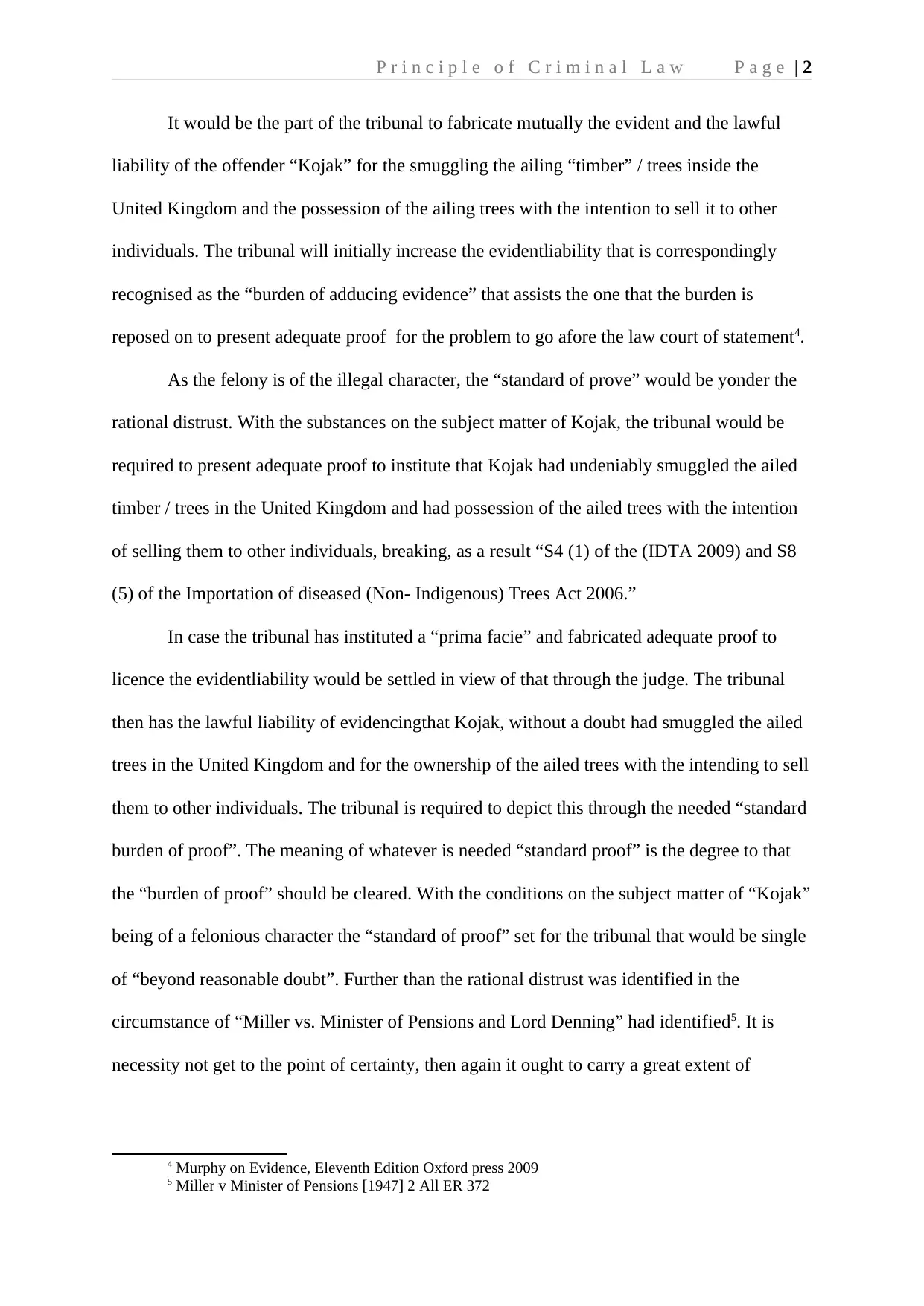
P r i n c i p l e o f C r i m i n a l L a w P a g e | 2
It would be the part of the tribunal to fabricate mutually the evident and the lawful
liability of the offender “Kojak” for the smuggling the ailing “timber” / trees inside the
United Kingdom and the possession of the ailing trees with the intention to sell it to other
individuals. The tribunal will initially increase the evidentliability that is correspondingly
recognised as the “burden of adducing evidence” that assists the one that the burden is
reposed on to present adequate proof for the problem to go afore the law court of statement4.
As the felony is of the illegal character, the “standard of prove” would be yonder the
rational distrust. With the substances on the subject matter of Kojak, the tribunal would be
required to present adequate proof to institute that Kojak had undeniably smuggled the ailed
timber / trees in the United Kingdom and had possession of the ailed trees with the intention
of selling them to other individuals, breaking, as a result “S4 (1) of the (IDTA 2009) and S8
(5) of the Importation of diseased (Non- Indigenous) Trees Act 2006.”
In case the tribunal has instituted a “prima facie” and fabricated adequate proof to
licence the evidentliability would be settled in view of that through the judge. The tribunal
then has the lawful liability of evidencingthat Kojak, without a doubt had smuggled the ailed
trees in the United Kingdom and for the ownership of the ailed trees with the intending to sell
them to other individuals. The tribunal is required to depict this through the needed “standard
burden of proof”. The meaning of whatever is needed “standard proof” is the degree to that
the “burden of proof” should be cleared. With the conditions on the subject matter of “Kojak”
being of a felonious character the “standard of proof” set for the tribunal that would be single
of “beyond reasonable doubt”. Further than the rational distrust was identified in the
circumstance of “Miller vs. Minister of Pensions and Lord Denning” had identified5. It is
necessity not get to the point of certainty, then again it ought to carry a great extent of
4 Murphy on Evidence, Eleventh Edition Oxford press 2009
5 Miller v Minister of Pensions [1947] 2 All ER 372
It would be the part of the tribunal to fabricate mutually the evident and the lawful
liability of the offender “Kojak” for the smuggling the ailing “timber” / trees inside the
United Kingdom and the possession of the ailing trees with the intention to sell it to other
individuals. The tribunal will initially increase the evidentliability that is correspondingly
recognised as the “burden of adducing evidence” that assists the one that the burden is
reposed on to present adequate proof for the problem to go afore the law court of statement4.
As the felony is of the illegal character, the “standard of prove” would be yonder the
rational distrust. With the substances on the subject matter of Kojak, the tribunal would be
required to present adequate proof to institute that Kojak had undeniably smuggled the ailed
timber / trees in the United Kingdom and had possession of the ailed trees with the intention
of selling them to other individuals, breaking, as a result “S4 (1) of the (IDTA 2009) and S8
(5) of the Importation of diseased (Non- Indigenous) Trees Act 2006.”
In case the tribunal has instituted a “prima facie” and fabricated adequate proof to
licence the evidentliability would be settled in view of that through the judge. The tribunal
then has the lawful liability of evidencingthat Kojak, without a doubt had smuggled the ailed
trees in the United Kingdom and for the ownership of the ailed trees with the intending to sell
them to other individuals. The tribunal is required to depict this through the needed “standard
burden of proof”. The meaning of whatever is needed “standard proof” is the degree to that
the “burden of proof” should be cleared. With the conditions on the subject matter of “Kojak”
being of a felonious character the “standard of proof” set for the tribunal that would be single
of “beyond reasonable doubt”. Further than the rational distrust was identified in the
circumstance of “Miller vs. Minister of Pensions and Lord Denning” had identified5. It is
necessity not get to the point of certainty, then again it ought to carry a great extent of
4 Murphy on Evidence, Eleventh Edition Oxford press 2009
5 Miller v Minister of Pensions [1947] 2 All ER 372
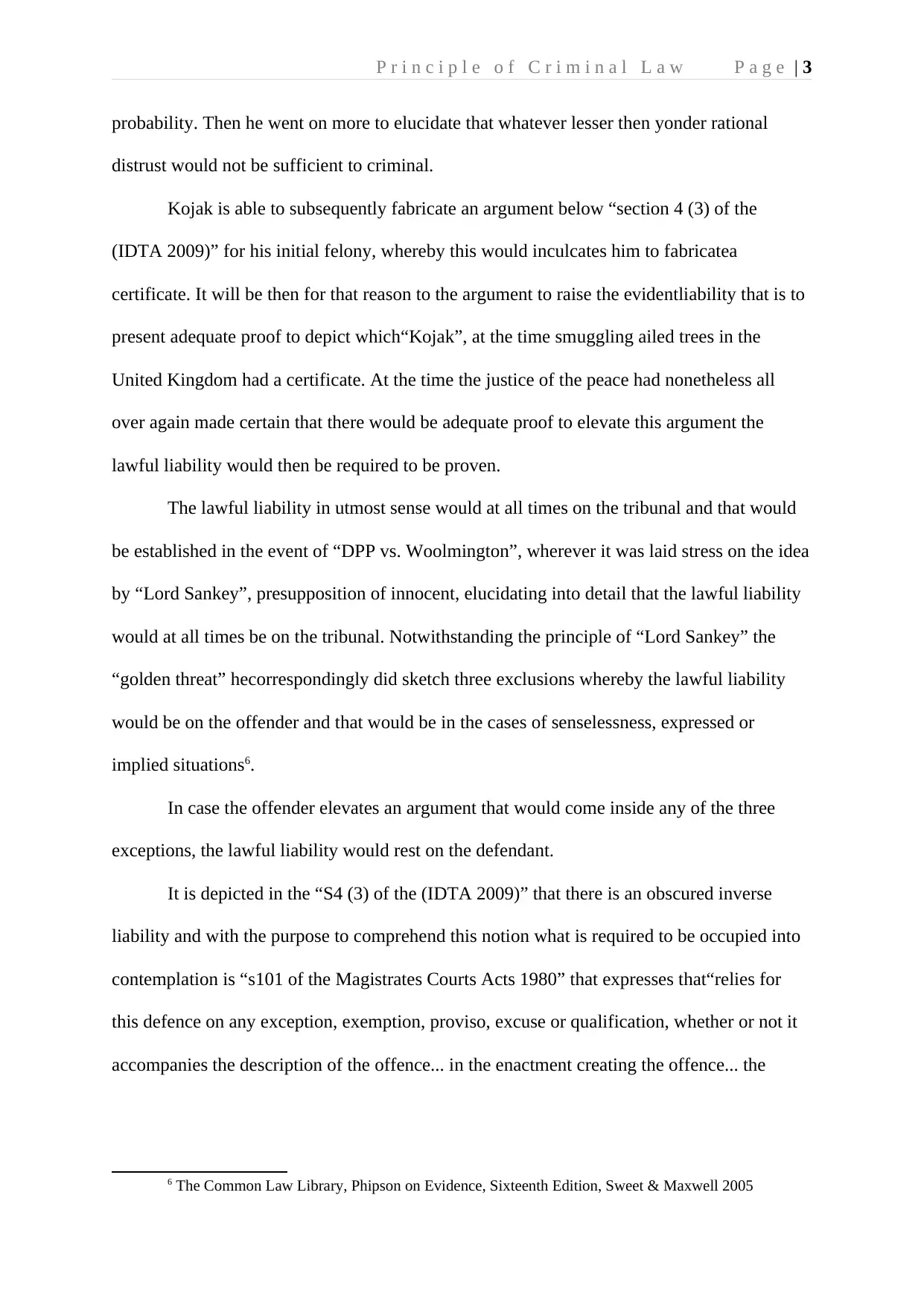
P r i n c i p l e o f C r i m i n a l L a w P a g e | 3
probability. Then he went on more to elucidate that whatever lesser then yonder rational
distrust would not be sufficient to criminal.
Kojak is able to subsequently fabricate an argument below “section 4 (3) of the
(IDTA 2009)” for his initial felony, whereby this would inculcates him to fabricatea
certificate. It will be then for that reason to the argument to raise the evidentliability that is to
present adequate proof to depict which“Kojak”, at the time smuggling ailed trees in the
United Kingdom had a certificate. At the time the justice of the peace had nonetheless all
over again made certain that there would be adequate proof to elevate this argument the
lawful liability would then be required to be proven.
The lawful liability in utmost sense would at all times on the tribunal and that would
be established in the event of “DPP vs. Woolmington”, wherever it was laid stress on the idea
by “Lord Sankey”, presupposition of innocent, elucidating into detail that the lawful liability
would at all times be on the tribunal. Notwithstanding the principle of “Lord Sankey” the
“golden threat” hecorrespondingly did sketch three exclusions whereby the lawful liability
would be on the offender and that would be in the cases of senselessness, expressed or
implied situations6.
In case the offender elevates an argument that would come inside any of the three
exceptions, the lawful liability would rest on the defendant.
It is depicted in the “S4 (3) of the (IDTA 2009)” that there is an obscured inverse
liability and with the purpose to comprehend this notion what is required to be occupied into
contemplation is “s101 of the Magistrates Courts Acts 1980” that expresses that“relies for
this defence on any exception, exemption, proviso, excuse or qualification, whether or not it
accompanies the description of the offence... in the enactment creating the offence... the
6 The Common Law Library, Phipson on Evidence, Sixteenth Edition, Sweet & Maxwell 2005
probability. Then he went on more to elucidate that whatever lesser then yonder rational
distrust would not be sufficient to criminal.
Kojak is able to subsequently fabricate an argument below “section 4 (3) of the
(IDTA 2009)” for his initial felony, whereby this would inculcates him to fabricatea
certificate. It will be then for that reason to the argument to raise the evidentliability that is to
present adequate proof to depict which“Kojak”, at the time smuggling ailed trees in the
United Kingdom had a certificate. At the time the justice of the peace had nonetheless all
over again made certain that there would be adequate proof to elevate this argument the
lawful liability would then be required to be proven.
The lawful liability in utmost sense would at all times on the tribunal and that would
be established in the event of “DPP vs. Woolmington”, wherever it was laid stress on the idea
by “Lord Sankey”, presupposition of innocent, elucidating into detail that the lawful liability
would at all times be on the tribunal. Notwithstanding the principle of “Lord Sankey” the
“golden threat” hecorrespondingly did sketch three exclusions whereby the lawful liability
would be on the offender and that would be in the cases of senselessness, expressed or
implied situations6.
In case the offender elevates an argument that would come inside any of the three
exceptions, the lawful liability would rest on the defendant.
It is depicted in the “S4 (3) of the (IDTA 2009)” that there is an obscured inverse
liability and with the purpose to comprehend this notion what is required to be occupied into
contemplation is “s101 of the Magistrates Courts Acts 1980” that expresses that“relies for
this defence on any exception, exemption, proviso, excuse or qualification, whether or not it
accompanies the description of the offence... in the enactment creating the offence... the
6 The Common Law Library, Phipson on Evidence, Sixteenth Edition, Sweet & Maxwell 2005
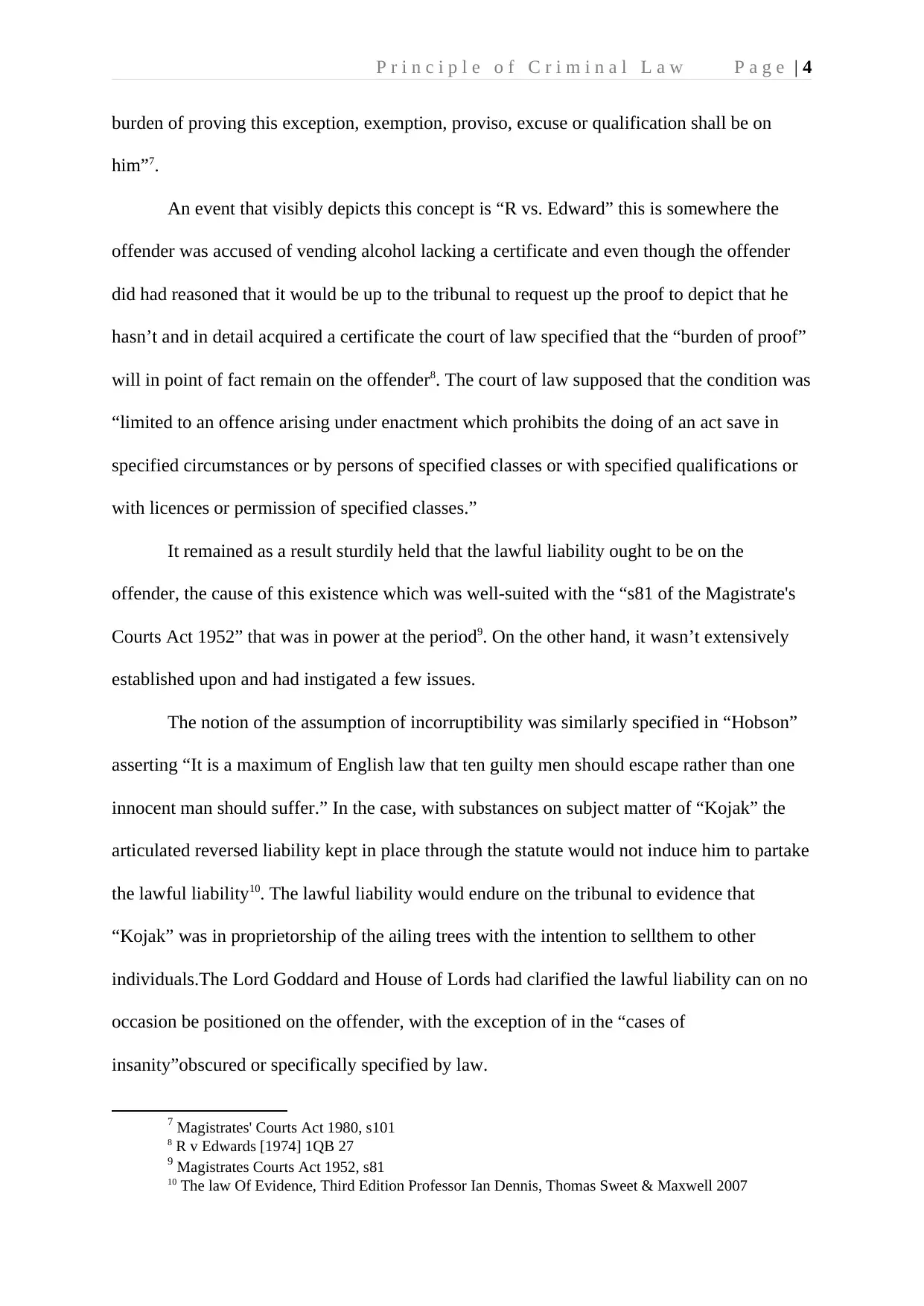
P r i n c i p l e o f C r i m i n a l L a w P a g e | 4
burden of proving this exception, exemption, proviso, excuse or qualification shall be on
him”7.
An event that visibly depicts this concept is “R vs. Edward” this is somewhere the
offender was accused of vending alcohol lacking a certificate and even though the offender
did had reasoned that it would be up to the tribunal to request up the proof to depict that he
hasn’t and in detail acquired a certificate the court of law specified that the “burden of proof”
will in point of fact remain on the offender8. The court of law supposed that the condition was
“limited to an offence arising under enactment which prohibits the doing of an act save in
specified circumstances or by persons of specified classes or with specified qualifications or
with licences or permission of specified classes.”
It remained as a result sturdily held that the lawful liability ought to be on the
offender, the cause of this existence which was well-suited with the “s81 of the Magistrate's
Courts Act 1952” that was in power at the period9. On the other hand, it wasn’t extensively
established upon and had instigated a few issues.
The notion of the assumption of incorruptibility was similarly specified in “Hobson”
asserting “It is a maximum of English law that ten guilty men should escape rather than one
innocent man should suffer.” In the case, with substances on subject matter of “Kojak” the
articulated reversed liability kept in place through the statute would not induce him to partake
the lawful liability10. The lawful liability would endure on the tribunal to evidence that
“Kojak” was in proprietorship of the ailing trees with the intention to sellthem to other
individuals.The Lord Goddard and House of Lords had clarified the lawful liability can on no
occasion be positioned on the offender, with the exception of in the “cases of
insanity”obscured or specifically specified by law.
7 Magistrates' Courts Act 1980, s101
8 R v Edwards [1974] 1QB 27
9 Magistrates Courts Act 1952, s81
10 The law Of Evidence, Third Edition Professor Ian Dennis, Thomas Sweet & Maxwell 2007
burden of proving this exception, exemption, proviso, excuse or qualification shall be on
him”7.
An event that visibly depicts this concept is “R vs. Edward” this is somewhere the
offender was accused of vending alcohol lacking a certificate and even though the offender
did had reasoned that it would be up to the tribunal to request up the proof to depict that he
hasn’t and in detail acquired a certificate the court of law specified that the “burden of proof”
will in point of fact remain on the offender8. The court of law supposed that the condition was
“limited to an offence arising under enactment which prohibits the doing of an act save in
specified circumstances or by persons of specified classes or with specified qualifications or
with licences or permission of specified classes.”
It remained as a result sturdily held that the lawful liability ought to be on the
offender, the cause of this existence which was well-suited with the “s81 of the Magistrate's
Courts Act 1952” that was in power at the period9. On the other hand, it wasn’t extensively
established upon and had instigated a few issues.
The notion of the assumption of incorruptibility was similarly specified in “Hobson”
asserting “It is a maximum of English law that ten guilty men should escape rather than one
innocent man should suffer.” In the case, with substances on subject matter of “Kojak” the
articulated reversed liability kept in place through the statute would not induce him to partake
the lawful liability10. The lawful liability would endure on the tribunal to evidence that
“Kojak” was in proprietorship of the ailing trees with the intention to sellthem to other
individuals.The Lord Goddard and House of Lords had clarified the lawful liability can on no
occasion be positioned on the offender, with the exception of in the “cases of
insanity”obscured or specifically specified by law.
7 Magistrates' Courts Act 1980, s101
8 R v Edwards [1974] 1QB 27
9 Magistrates Courts Act 1952, s81
10 The law Of Evidence, Third Edition Professor Ian Dennis, Thomas Sweet & Maxwell 2007
Secure Best Marks with AI Grader
Need help grading? Try our AI Grader for instant feedback on your assignments.
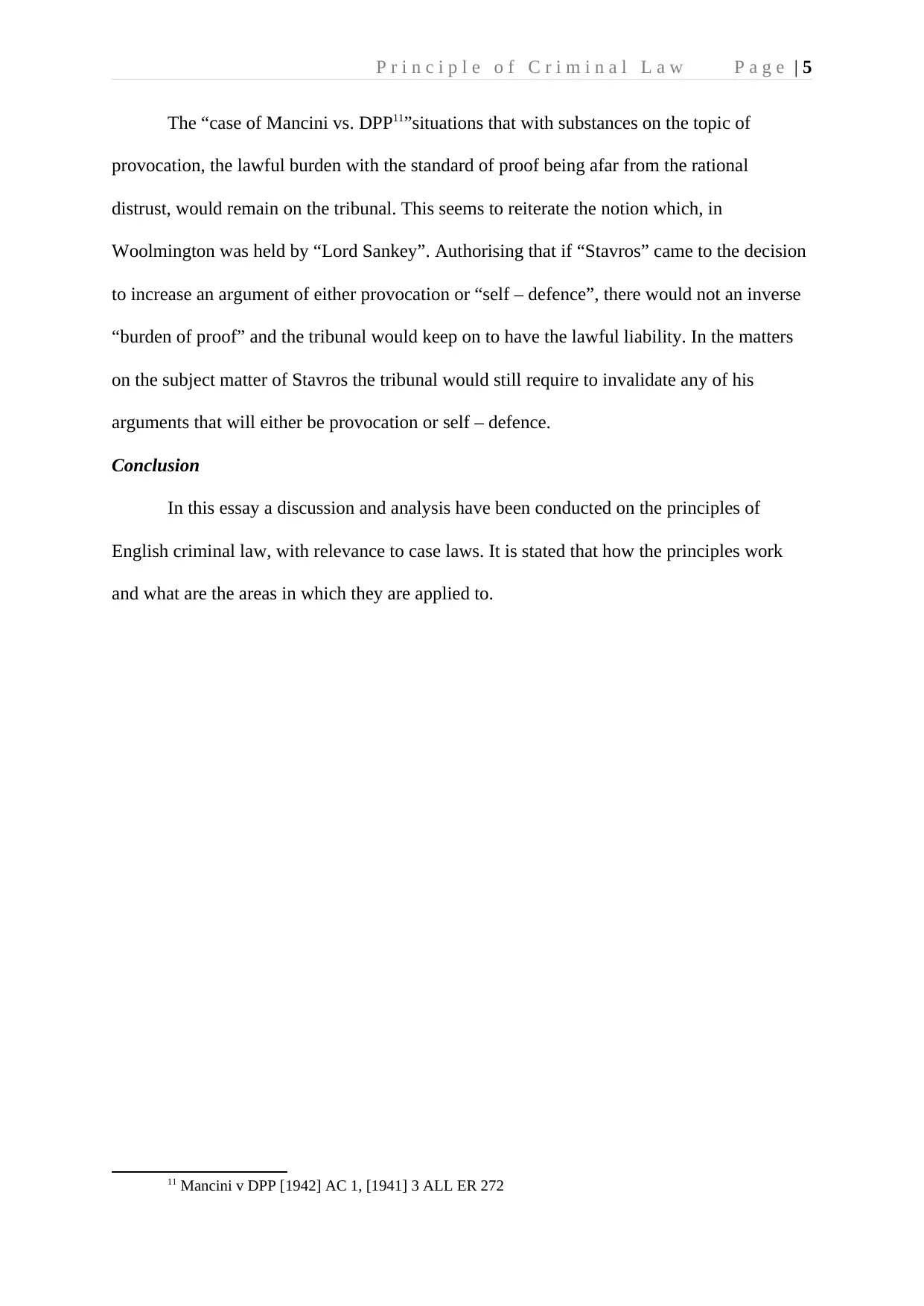
P r i n c i p l e o f C r i m i n a l L a w P a g e | 5
The “case of Mancini vs. DPP11”situations that with substances on the topic of
provocation, the lawful burden with the standard of proof being afar from the rational
distrust, would remain on the tribunal. This seems to reiterate the notion which, in
Woolmington was held by “Lord Sankey”. Authorising that if “Stavros” came to the decision
to increase an argument of either provocation or “self – defence”, there would not an inverse
“burden of proof” and the tribunal would keep on to have the lawful liability. In the matters
on the subject matter of Stavros the tribunal would still require to invalidate any of his
arguments that will either be provocation or self – defence.
Conclusion
In this essay a discussion and analysis have been conducted on the principles of
English criminal law, with relevance to case laws. It is stated that how the principles work
and what are the areas in which they are applied to.
11 Mancini v DPP [1942] AC 1, [1941] 3 ALL ER 272
The “case of Mancini vs. DPP11”situations that with substances on the topic of
provocation, the lawful burden with the standard of proof being afar from the rational
distrust, would remain on the tribunal. This seems to reiterate the notion which, in
Woolmington was held by “Lord Sankey”. Authorising that if “Stavros” came to the decision
to increase an argument of either provocation or “self – defence”, there would not an inverse
“burden of proof” and the tribunal would keep on to have the lawful liability. In the matters
on the subject matter of Stavros the tribunal would still require to invalidate any of his
arguments that will either be provocation or self – defence.
Conclusion
In this essay a discussion and analysis have been conducted on the principles of
English criminal law, with relevance to case laws. It is stated that how the principles work
and what are the areas in which they are applied to.
11 Mancini v DPP [1942] AC 1, [1941] 3 ALL ER 272
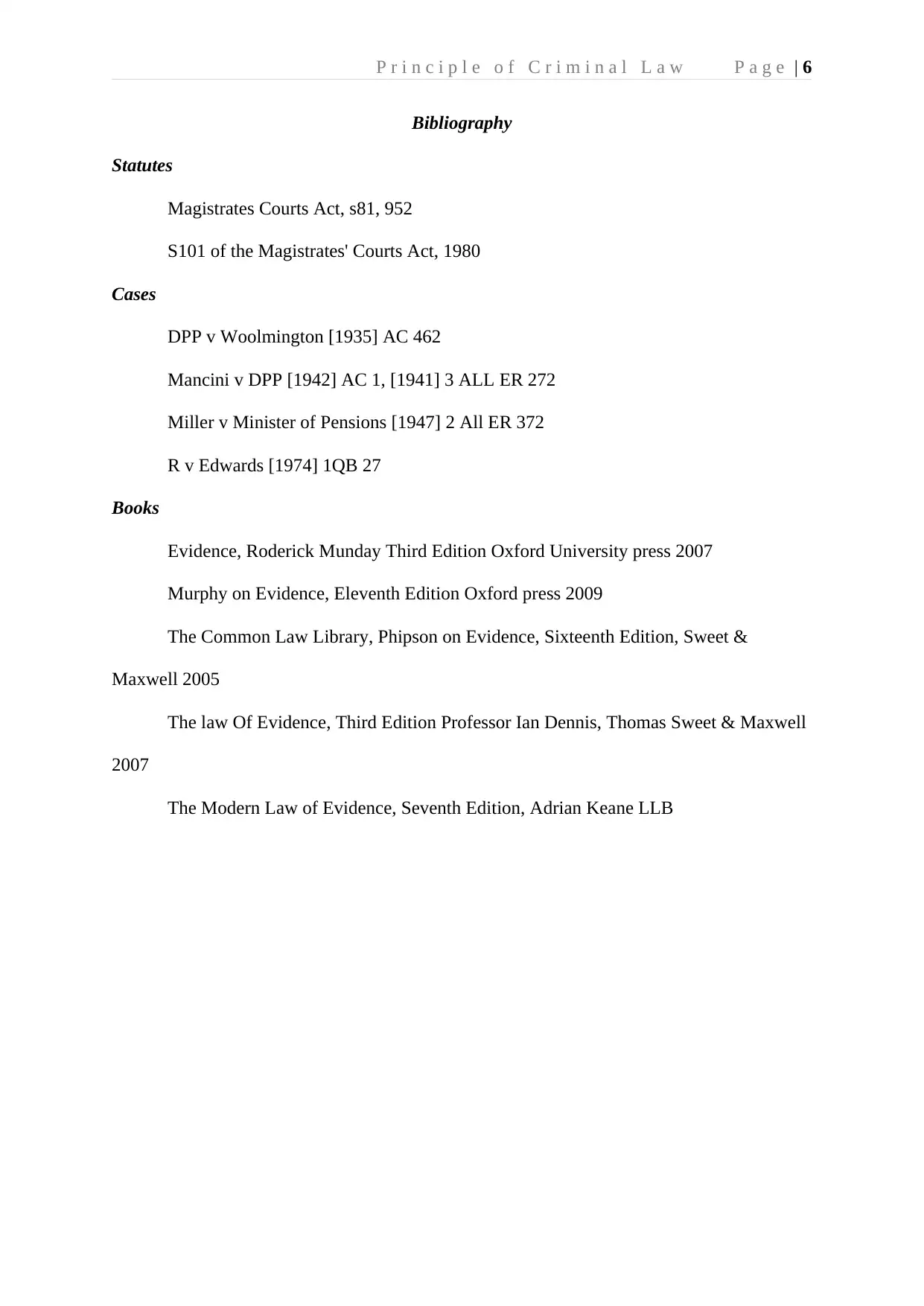
P r i n c i p l e o f C r i m i n a l L a w P a g e | 6
Bibliography
Statutes
Magistrates Courts Act, s81, 952
S101 of the Magistrates' Courts Act, 1980
Cases
DPP v Woolmington [1935] AC 462
Mancini v DPP [1942] AC 1, [1941] 3 ALL ER 272
Miller v Minister of Pensions [1947] 2 All ER 372
R v Edwards [1974] 1QB 27
Books
Evidence, Roderick Munday Third Edition Oxford University press 2007
Murphy on Evidence, Eleventh Edition Oxford press 2009
The Common Law Library, Phipson on Evidence, Sixteenth Edition, Sweet &
Maxwell 2005
The law Of Evidence, Third Edition Professor Ian Dennis, Thomas Sweet & Maxwell
2007
The Modern Law of Evidence, Seventh Edition, Adrian Keane LLB
Bibliography
Statutes
Magistrates Courts Act, s81, 952
S101 of the Magistrates' Courts Act, 1980
Cases
DPP v Woolmington [1935] AC 462
Mancini v DPP [1942] AC 1, [1941] 3 ALL ER 272
Miller v Minister of Pensions [1947] 2 All ER 372
R v Edwards [1974] 1QB 27
Books
Evidence, Roderick Munday Third Edition Oxford University press 2007
Murphy on Evidence, Eleventh Edition Oxford press 2009
The Common Law Library, Phipson on Evidence, Sixteenth Edition, Sweet &
Maxwell 2005
The law Of Evidence, Third Edition Professor Ian Dennis, Thomas Sweet & Maxwell
2007
The Modern Law of Evidence, Seventh Edition, Adrian Keane LLB
1 out of 6
Your All-in-One AI-Powered Toolkit for Academic Success.
+13062052269
info@desklib.com
Available 24*7 on WhatsApp / Email
![[object Object]](/_next/static/media/star-bottom.7253800d.svg)
Unlock your academic potential
© 2024 | Zucol Services PVT LTD | All rights reserved.